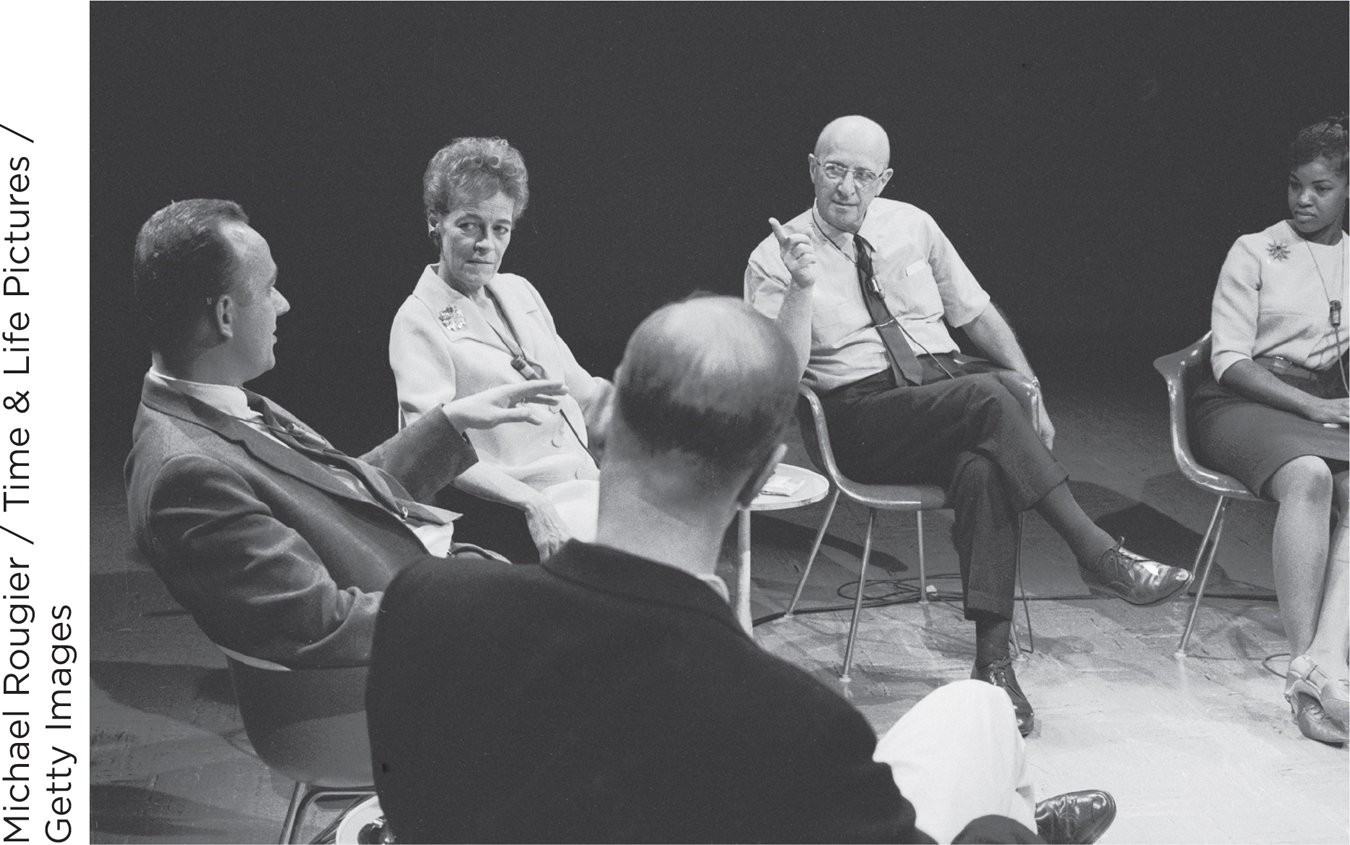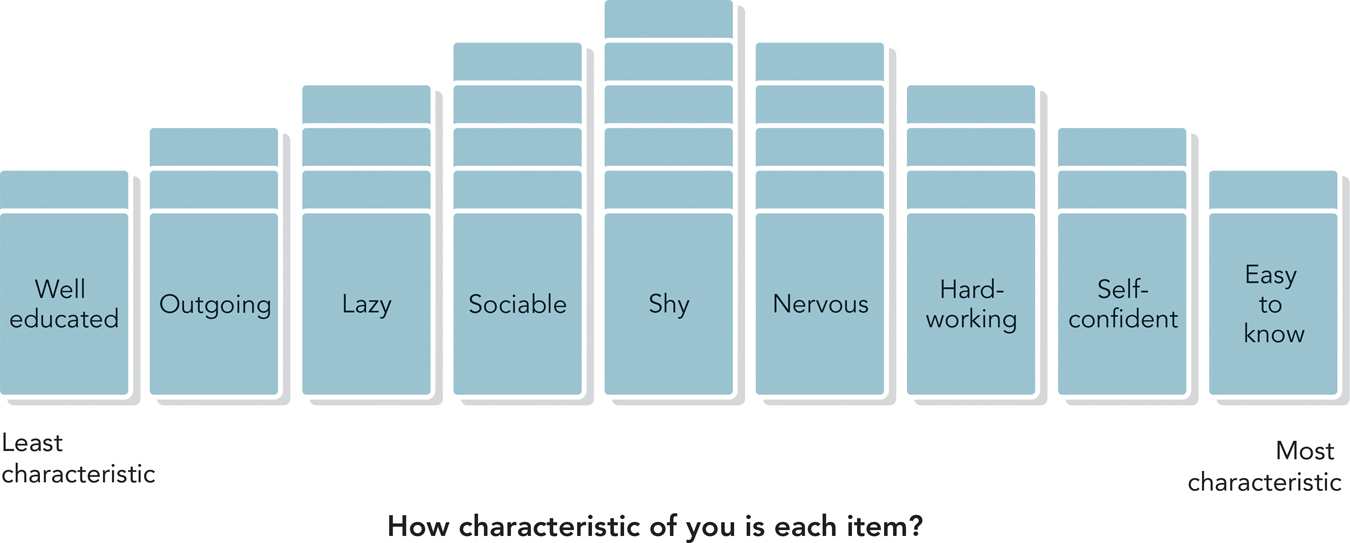13.4 Humanistic Theory
Preview Question
Question
 What does humanistic theory emphasize, in contrast with psychoanalysis?
What does humanistic theory emphasize, in contrast with psychoanalysis?
Who’s your favorite person—
Freud said little about friendships and experiences of one’s true self. Humanistic theory rectifies this oversight. Humanistic theory is an approach to personality that focuses on people’s thoughts and feelings about themselves and the ways that interpersonal relationships shape those feelings. Humanistic psychologists emphasize people’s conscious experiences (rather than Freud’s emphasis on the unconscious), their search for meaning in life, and their capacity to make choices that can make their lives more meaningful.

How important have your personal relationships been to the development of your personality?
In these regards, the humanistic viewpoint is the very opposite of Freud’s. In Freudian theory, the most powerful personality system is the id, which is concerned with gratifying bodily needs. In humanistic theory, the major personality structure is the self, and the major personality process is the individual’s quest to develop a meaningful self-
Many psychologists contributed to humanistic personality theory. But unique contributions were made by a psychologist from Illinois, Carl Rogers. Rogers first planned to be a minister. His religious training made him aware of people’s struggle to attain a deep sense of personal meaning in their lives (Kirschenbaum, 1979). After studying scientific psychology and receiving training as a psychotherapist, Rogers developed a theory of personality centered on the self.
WHAT DO YOU KNOW?…
Question 10
In what ways does the humanistic viewpoint differ from Freud’s psychoanalytic theory?
- lqdq4yUdE87i+6FLF0JyvlS4K9/fri+ik8gUkzwYBcRvu3YeHdN3Eq/Ki+jl7BLGsRpV42A0UnDWyjcy4j2s4PjkJRZyjg1pwwt7LIbg/eHaInSFQs7hhwWNpdzKLja+un1aFVznMw9UtGJ7W5sJOcOKZA4ETM0G7S398MWinMLKayJ9JNrQpFR4L4iNMA7j/a/9WE1cIhd+7R3VAuVPxoRtS8EHvVUh1aDwpbFgkhUTTAfI9hZJtSLI6rmvWeL/5rYWOQ==
- jT85DxRG8LCvA6L7IH1qJhKRrkWAi06oPtb4kWqRhlEShg3XYlb8BZ164LcqSkFbFs848cwjsSbimk9iwDktEYi49e6K1vQTNzm0ZfFWjD4j3E78KAO323zYEIUeyX/apsLLURaBsik74jdSYC71WblGR25+CVZQnI3F+cLLqLM=
- WkX4mut3yYcloj2GMSaW97qXQFhNHOu96OS5Bx2ZlaBJayGy7pueRLDbgPqD9OhHaEAZz5nIDCXJAFDlSye0tMmB3kiAcUjMa54m0Y4YtGSxvI8pLjrBWP3TRsdHCXUfMAISAfVqrm/2PiUktW+wC/D3lPnkXDb/eDOJyY0bv2Pw5VX26cRGJuudn39vUo40XfIJfQ==
- RhIkGWeTtpDHtoMVURhxMNvM1junJM0DGmLPU3sqmsSUkyJRn07mApUwDviGjo14KYslT7C3bJnrJ7wNNCZst/uDIwg7WhPIhrvTElMI4w2tKgiah6zprddGjvnniqZ8/a4jkJ75ZviCB/nNwN6KxgQx5cY=
- zEm31ibvNI4DEuxP3p20xytTt0Vn0tn5dkvcR8s1YZJbIq6nSVBPqmk05YTKe+qGKRVP7nSz0bYD6/dt/Q3d92RrcrAGT3DFleEInbuPzZ7Hv/2MKotdfdGMhdrFoJtIxMR9aAiTTEW/1VR6
Structure: The Self Concept
Preview Questions
Question
 What is “the self” and why did Rogers emphasize it in his theory of personality?
What is “the self” and why did Rogers emphasize it in his theory of personality?
 What is the source of our emotions according to humanistic theory?
What is the source of our emotions according to humanistic theory?

Rogers was an exceptionally skilled therapist. By listening attentively to his clients, he not only helped them, but also learned from them. The critical lesson he learned was that the overarching question people ask themselves is, “Who am I—
THE SELF. In Rogers’s humanistic theory of personality, the self refers to people’s conception of who they are. Rogers’s idea is straightforward: Through our daily experiences, we learn about ourselves. We observe our strengths and weaknesses. We learn how we’re similar to and different from other people. We learn what others think of us. When we consciously reflect on all this information, we try to organize it into a coherent portrait of who we really are. The result is the self (or self-
What would your life be like if you didn’t have a sense of self? Could you experience disappointment? Satisfaction?
Therapy taught Rogers a second lesson: The self can change. People can alter and improve their self-
ACTUAL AND IDEAL SELF. Rogers identified two aspects of the self: the actual and ideal self. The actual self is people’s perceptions of how they are in the present. The ideal self is a set of self-
The actual and ideal often do not match up. People would like to be a certain kind of person, but when they look in the mirror they see someone else. For instance, you might see yourself as fun-
How would you describe your actual and ideal selves?
Discrepancies between the actual and ideal self produce distress. People feel disappointment in their actual self, guilty about not being better, and worried about ever attaining their ideal. Rather than accepting themselves as they are, they imagine an ideal self—
567
THINK ABOUT IT
Rogers said that his clients’ poor self-
WHAT DO YOU KNOW?…
Question 11
According to Rogers, the result of our tendency to consciously reflect on our experiences is an organized l6qUgfjZDqPCyaqCFhcwVicgOg4=, which has the capacity to 5iAX9LgmAlU1fY4J. The key source of emotion is a discrepancy between the hKoRJ64rYGj6elUl and r1PawyNb2gvAnBMt selves.
Process: The Growth of the Self
Preview Questions
Question
 What is the fundamental human motive according to Rogers?
What is the fundamental human motive according to Rogers?
 How can our relationships with others foster or hinder self-
How can our relationships with others foster or hinder self-
Rogers proposed an optimistic, positive view of personality processes. Rather than emphasizing sexual and aggressive drives, as Freud did, Rogers highlighted people’s desire for self-
SELF-
Again, it was experiences in therapy that guided Rogers’s theorizing. In case after case, he observed clients recovering from personal setbacks. They fought to improve their psychological lives, and they usually succeeded. Rogers attributed their success to their inner strength—
THINK ABOUT IT
Rogers’s personality theory was based on experiences with his clients, who generally were from the United States. Might his personality theory have differed if he had worked with a wider range of the world’s citizens?
CONDITIONS OF WORTH. If we’re all motivated toward self-
Rogers’s answer is that people often experience conditions of worth. A condition of worth is a requirement for a person’s behavior; specifically, it is a requirement that must be met if the person is to be fully valued, loved, and respected by others. Imagine, for example, a child who is interested in art, uninterested in sports, and whose parents are big sports fans. If the parents indicate, by their words or actions, that the child will be fully loved and respected only by excelling at sports rather than art, then they are imposing a condition of worth. The parents’ behavior may cause the child to reject his interest in art, to pursue sports instead, and thus to lose touch with an aspect of his true self.
Contrast this situation with one in which the parents love and respect their child no matter what his interests may be. In this case, the child experiences unconditional positive regard, a consistent expression of respect and acceptance.
568
Rogerian theory predicts that these different types of relationships have different effects on personality development. Unconditional positive regard enables people to explore the world confidently and to develop their true self. People know that they can try out new activities, take chances, and sometimes fail without losing the acceptance of others. By contrast, when relationships feature conditions of worth, people are forced to deny aspects of their true self in order to gain the acceptance of others. They become defensive and cautious, lose touch with their true self, and fail to grow toward self-
Who are the people in your life who love you unconditionally?
WHAT DO YOU KNOW?…
Question 12
The following statements are incorrect. Explain why.
- 2Wa99hse8ZSosRyWpYXyVPykERau+Li3I6a2Ra9ms0vP86oxtvf9a984R4cy6Pm1qqi0ndb8W5qDPh3qfLcaH5/8zqzbRwlXBI/8T0KWnFYcg+osy2vtivhzdCEapqPrH4xQXhH0aYDICZFj6VbT8E1kC8yjhV//llP/iMGpoIEG+D3C+s0vv6UljiJwpDIWGmK1uw==
- GKyjRver6rMRas3qfYfU0kLx0ISnZYYL9kyAkRBbaZFfvjHt0XM+aOILcZEa8dlU+VQtCS9DNhO6upfiRAe6k8WUXt4ueFUWysxiKa4r4cgl/+zmgnDRHc1jIjD6dFFuU5NbrqozaPw=
a. This statement is incorrect because Rogers claimed that the drive to attain self-actualization was universal. b. This statement is incorrect because the child is only free to develop his or her true sense of self if he or she receives unconditional positive regard. Conditions of worth cause the child to deny aspects of the self.

Assessment: Measuring Self-Perceptions
Preview Question
Question
 How can we measure self-
How can we measure self-
Unlike Freud, Rogers used the methods of psychological science to assess personality in an efficient, reliable manner. Because the central structure in Rogers’s theory is the self, his main assessment goal was to assess self-
ASSESSING SELF-
When taking a Q-

The Q-
TRY THIS!
The Q-
Q-
569
WHAT DO YOU KNOW?…
Question 13
True or False?
- PXWuduo43pisu1xQ8gns416mw7gzzT/UGdnBIsZIto/qJk7tGwBccOgFa0tTNF3ZvuOkF56lf+QanuOeI7O+ugdFDZGhzHISHP01dbe/IanyLe1LkOA2VtSM0p3hT46eOpqzKZVPZdN+c1YkppkbQFMQ6PIDtiTwe/PGLrgdRpsfYsGBVLm6wXYLsuvQEpNEIZKcIfUbq/nYro4UR4DyYArPBNqtev5S2oWzV5L+zsbu8GtT3WvhpQ==
- C3U6+0aVHVyqM8CiOpl4Zv0rcW8Pe1kpHRHnxIq4E6m+yXZfmn1npa+L7LDXT5VqG5YSHwzGVwaUqDBUYzE2phqz8ePUq/45aMQrAYKShOxAP7HLhOi+VrC/x480pzMjv4qOEG2I7ctnCSmVzFbodIT2otW0LR9NQhtIL7upGrgMwrTotDiAoz2w8loQgtUK7zKI0Vo/4YZpHRGdq1fUMaNNWYvjZUDVsJD6j+YyVeTFL3iORC1Jy7/kZwH3Qo+thAWmLz1VdtViRtcYWPt7iN7AWcBTIEZFCs5M+Q==
Evaluation
Preview Questions
Question
 In what way does Rogers’s theory improve upon Freud’s?
In what way does Rogers’s theory improve upon Freud’s?
 In what way is Rogers’s theory limited as a theory of personality?
In what way is Rogers’s theory limited as a theory of personality?
Rogers’s humanistic theory was historically significant for personality psychology. It shifted the field’s focus from the unconscious mind to conscious thoughts about the self, and from animalistic drives to the uniquely human tendency to actualize the self. Rogers developed a positive, uplifting psychology that drew attention to people’s capacity to recover from setbacks and attain meaningful lives. The enduring importance of his thinking is evident from recent developments in psychology. Many psychologists today contribute to a positive psychology movement that focuses attention on human strengths, virtues, and conditions of life that enable people to develop optimally (Gable & Haidt, 2005; Keyes, Fredrickson, & Park, 2012). These are precisely the themes highlighted by Rogers. If he were still alive, he surely would be pleased to see twenty-
The main limitation of Rogers’s theory is that it is not sufficiently comprehensive. There are significant aspects of personality about which Rogers’s theory says little. One is personality’s “biological side”—individual differences in personality that may be inherited and evident early in life. As knowledge of human genetics grew in the second half of the twentieth century, researchers became increasingly interested in the biological foundations of personality. This interest triggered the development of a third approach to personality, trait theory.
570
WHAT DO YOU KNOW?…
Question 14
True or False?

CULTURAL OPPORTUNITIES
Self-Esteem
Personality theorists have global ambitions. They aim to develop theories that apply universally, to all cultures of the world. Have they succeeded?
In many ways, they have; numerous aspects of psychological life described in personality theories are universal (Brown, 1991). No matter where you go, people engage in both conscious and unconscious thinking (as psychoanalytic theory suggests), benefit from warm human relationships (as humanistic theory emphasizes), learn from psychological models (explored in social-
In the United States, most people score well above the midpoint on self-
Cultural factors explain this difference. In the United States, many social practices and institutions are designed to enhance self-
Students’ reactions to test results reveal this cultural difference. In Japan, university students who receive negative feedback tend to accept it as valid; bad test scores prompt them to question their abilities. In North America, students tend to question not themselves but the test; they often are as sure of their high abilities after receiving a bad test score as before (Heine, Kitayama, & Lehman, 2001).
To achieve their global ambitions, personality theorists need to attend to the diversity of the world’s cultures.